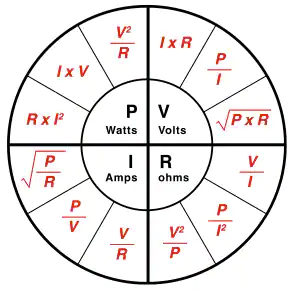Ohm’s Law Calculator | Calculator for Ohm’s Law.
Ohm’s Law: Understanding the Relationship between Voltage, Current, and Resistance.
Ohm’s Law is a fundamental concept in electrical engineering that describes the relationship between voltage, current, and resistance in an electrical circuit. It is named after Georg Simon Ohm, a German physicist who first discovered this relationship in the 1820s. Ohm’s Law Calculator Online.
Ohm's Law Calculator

Ohms law power formula
Ohm’s Law states that the current flowing through a conductor between two points is directly proportional to the voltage across the two points and inversely proportional to the resistance between them. In other words, the greater the voltage applied to a circuit, the greater the current that will flow through it. Similarly, the higher the resistance in a circuit, the lower the current that will flow through it.
Mathematically, Ohm’s Law can be represented as I = V/R, where I is the current in amperes, V is the voltage in volts, and R is the resistance in ohms. This simple equation is the basis for many electrical calculations, including power, energy, and circuit analysis.
To better understand the relationship between voltage, current, and resistance, let’s take a closer look at each of these parameters:
Voltage: Voltage is a measure of the electrical potential difference between two points in a circuit. It is often compared to the pressure in a water pipe, where higher pressure leads to a greater flow of water. Similarly, higher voltage leads to a greater flow of current in an electrical circuit. Ohm’s Law Calculator Calculator for Ohm’s Law
Current: Current is the flow of electric charge through a conductor. It is measured in amperes (A) and represents the rate at which electric charge flows through a circuit. In a simple circuit, the current is the same throughout the circuit, and its value depends on the voltage applied and the resistance of the circuit.
Resistance: Resistance is a measure of how much a material opposes the flow of electric current. It is measured in ohms (Ω) and can be affected by factors such as temperature, material properties, and the physical geometry of the conductor. In a simple circuit, the resistance is the same throughout the circuit, and its value affects the current that flows through the circuit. ohm’s law calculation
Understanding Ohm’s Law is essential for anyone working with electrical circuits, from engineers and technicians to hobbyists and students. By applying this law, it is possible to design and analyze circuits, troubleshoot problems, and select appropriate components for a specific application.
In summary, Ohm’s Law describes the relationship between voltage, current, and resistance in an electrical circuit. By understanding this relationship, it is possible to make accurate calculations and create efficient, reliable electrical systems.


 Soldering Item’s
Soldering Item’s Other Item’s
Other Item’s PCB’s
PCB’s Micro IC
Micro IC DSP Card
DSP Card Driver Card
Driver Card Fuse & Holder
Fuse & Holder MOSFET & IGBT
MOSFET & IGBT Regulator IC
Regulator IC